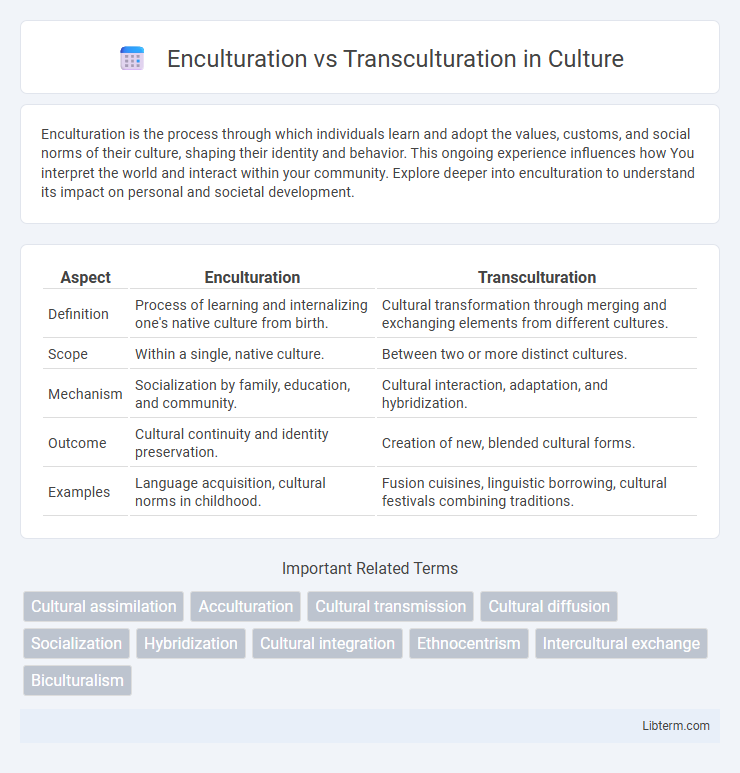Enculturation is the process through which individuals learn and adopt the values, customs, and social norms of their culture, shaping their identity and behavior. This ongoing experience influences how You interpret the world and interact within your community. Explore deeper into enculturation to understand its impact on personal and societal development.
Table of Comparison
| Aspect | Enculturation | Transculturation |
|---|---|---|
| Definition | Process of learning and internalizing one's native culture from birth. | Cultural transformation through merging and exchanging elements from different cultures. |
| Scope | Within a single, native culture. | Between two or more distinct cultures. |
| Mechanism | Socialization by family, education, and community. | Cultural interaction, adaptation, and hybridization. |
| Outcome | Cultural continuity and identity preservation. | Creation of new, blended cultural forms. |
| Examples | Language acquisition, cultural norms in childhood. | Fusion cuisines, linguistic borrowing, cultural festivals combining traditions. |
Defining Enculturation and Transculturation
Enculturation is the process by which individuals learn and adopt the values, customs, and norms of their own culture through direct experience and socialization. Transculturation refers to the blending and merging of elements from different cultures, resulting in new cultural expressions or hybrid identities. While enculturation emphasizes internal cultural transmission, transculturation highlights interactive cultural exchange and transformation.
Key Differences Between Enculturation and Transculturation
Enculturation is the process by which individuals learn and adopt the values, norms, and behaviors of their native culture, typically occurring during childhood through family and community interactions. Transculturation involves the merging and converging of different cultures, resulting in the creation of new cultural phenomena through the exchange and adaptation of cultural elements. The key difference lies in enculturation being the internalization of a single culture, while transculturation emphasizes cultural blending and transformation between distinct cultural groups.
The Process of Enculturation: How Culture Shapes Identity
Enculturation is the lifelong process through which individuals absorb and internalize the norms, values, language, and customs of their native culture, fundamentally shaping their identity and worldview. This dynamic process begins in early childhood and continues as individuals interact with family, community, and societal institutions, reinforcing a sense of belonging and cultural continuity. Strong enculturation fosters cultural coherence and self-understanding, influencing behavior, beliefs, and social roles within the cultural group.
Transculturation: Blending and Transforming Cultures
Transculturation involves the dynamic process of blending and transforming cultures through mutual exchange, resulting in new cultural expressions and identities. This phenomenon goes beyond simple cultural borrowing by creating hybrid practices that integrate elements of different traditions, often seen in art, language, and social customs. The process highlights the fluid nature of culture, emphasizing adaptation and innovation rather than one-way assimilation.
Historical Examples of Enculturation
Historical examples of enculturation include Indigenous communities passing down language, customs, and rituals through oral traditions and apprenticeship, ensuring cultural continuity across generations. Colonial education systems often imposed dominant cultural values on native populations, reshaping identities while preserving elements of original cultural frameworks. Traditional festivals and rites of passage serve as key mechanisms for enculturation, embedding shared cultural norms and social roles within societies worldwide.
Notable Cases of Transculturation in Modern Society
Notable cases of transculturation in modern society include the fusion of Latin American and U.S. cultures seen in the vibrant Chicano movement, which blends indigenous Mexican heritage with American social and political ideas. The global spread of K-pop exemplifies transculturation as it merges traditional Korean culture with Western music styles, fashion, and digital media platforms. Urban multicultural neighborhoods, such as London's Brick Lane or New York's Jackson Heights, demonstrate transculturation through the continuous exchange and adaptation of diverse cultural practices, languages, and cuisines.
Factors Influencing Enculturation and Transculturation
Enculturation is primarily influenced by family upbringing, social environment, and cultural rituals that instill native language, beliefs, and values from an early age. Transculturation occurs through migration, globalization, and intercultural communication, facilitating the exchange and adaptation of cultural traits between different societies. Both processes are shaped by power dynamics, identity negotiation, and the socio-political context in which cultural interactions take place.
The Impact on Individual and Collective Identity
Enculturation shapes individual and collective identity by embedding cultural norms, values, and practices from birth, fostering a cohesive sense of belonging within a community. Transculturation transforms identity through the merging of distinct cultures, producing hybrid identities that challenge traditional boundaries and promote cultural innovation. The interplay between these processes influences how individuals negotiate their sense of self and communal affiliation in increasingly interconnected societies.
Challenges and Benefits of Cultural Exchange
Enculturation involves the gradual acquisition of a single culture's norms and values, often leading to deep-rooted identity and stability but posing challenges in adapting to multicultural environments. Transculturation, the process of merging and converging cultures, promotes creativity and innovation by blending diverse traditions, though it may result in identity conflicts and cultural dilution. Both processes facilitate cultural exchange, with enculturation providing a strong cultural foundation and transculturation enabling dynamic intercultural dialogue and mutual enrichment.
Enculturation vs. Transculturation: Implications for Globalization
Enculturation involves individuals learning and internalizing the norms and values of their native culture, shaping identity and social behavior within a specific cultural context. Transculturation refers to the dynamic process of cultural exchange and transformation occurring as different cultures interact, leading to hybrid cultural forms and mutual influence. Understanding the distinction between enculturation and transculturation is crucial in globalization studies, as they highlight how cultural continuity and change coexist amid global interconnectedness, impacting identity formation and cultural integration worldwide.
Enculturation Infographic

 libterm.com
libterm.com